| 日本の産業革命の地・横須賀 従来、日本の工業の原動力は人力―牛馬力ー水力までだった。横須賀製鉄所ははじめからすべての工場が蒸気機関を原動力としていたから「蒸気機関を原動力とする日本最初の総合工場」といえる。まさに日本産業革命の地である。司馬遼太郎が「日本の近代工学のいっさいの源泉」(「三浦半島記」)と書いたのは、このことを指す。 |
Yokosuka, the site of Japan's Industrial Revolution In the past, the driving force of Japanese industry was human power, cattle and horses, and even water wheels. Since the Yokosuka Ironworks was powered by steam engines from the beginning, it can be called "Japan's first integrated plant powered by the steam engine. It is truly the site of Japan's industrial revolution. This is what Ryotaro Shiba meant when he wrote that it was "the source of all modern engineering in Japan." (Miura Peninsula Chronicles) |
|---|---|
| 「知事からは、いつも現場へ出るようにと言われますが……」 新しい県庁で会った県の幹部は、いま駐車場工事中でマイカー通勤が 禁止ということもあって、高層の部屋で仕事をしていると外へ出かけ
るのがついおっくうになる、とこぼした。現場へ出ないで仕事をすると、思わぬミスを招くこともあろう。高層化したらよけい現場に出る ことを心がけてほしいものだ。 現場といえば、今は米軍基地になっている横須賀造船所に、幕末に 購入したハンマーが残っていると聞いて、1996平成8年11月に見学に入った。案内されて驚いたのはその大きなこと。高さ約五メートルも ある半円形の鉄のアーチがどっしり据えられている。しかも、工場長 は「ちょうど仕事が入っているので動かします」と言う。 |
"The governor is always telling us to go out to the field. ......"
A prefectural official I (Taiken Murakami) met at the new prefectural office
told me that he was working at an upper floor room of a high-rise building
and became reluctant to go out because commuting by car was prohibited
due to the construction of the parking lot. If the government staff work
without seeing the field, they may make unexpected mistakes. I hope they
will go out to the field as much as possible especially when they have
to work in high-rise buildings. Speaking of the field, I heard that the hammer purchased at the end of the Edo period still existed in the Yokosuka Shipyard, which is now a U.S. military base, so I visited the shipyard in November 1996 along with some other people. I was surprised at the size of the hammer when we were shown around. The hammer was a five-meter high semicircular iron arch, which was placed in a weighty manner. The manager of the plant said, "We have some work to do, so we will operate it now. |
|
驚く私たちの目の前に、すぐに真っ赤に焼かれた三〇〇キロの鋼材 が天井のクレーンで運ばれ、アーチの中央のハンマーの真下に据えら れると、ハンマーがスチームの力によりハンドル一本でスッと上がり、
自重三トンの凄い響きで打ち落とされる。 |
In front of our surprised eyes, 300 kilograms of red-hot steel was immediately
carried by an overhead crane and placed right under the hammer in the center
of the arch. Then, the hammer was raised by the power of steam with a single
stroke of the handle, and struck down with the awesome sound of its own
weight of three tons. After several repetitions, it was immediately formed into a mushroom-like shape. When I asked him what it was, he told me in my ear, "It's a secret, but the boiler on the aircraft carrier Independence had a malfunction and we received an order for bolts, so we're hitting it." To my surprise, he was making parts for a state-of-the-art aircraft carrier with a machine Japan had purchased 130 years ago, at the end of the Edo period! Tools from that time are still in use today in the facility that Kozukenosuke Oguri promoted the construction of, confident that it would be useful for the modernization of Japan. My heart became fraught with emotion. |
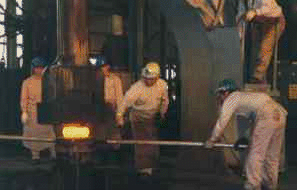 I I |
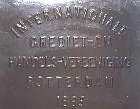 ハンマー基部の文字 INTERNATIONALE CREDIET-EN HANDELS-VEREENIGING ROTTERDAM 1865 |
| ▲スチームハンマー(3トン) マザーマシンと呼ばれ、あらゆる機具の母機として活躍した。 |
Steam hammer (3 tons) Called the mother machine, it served as the mother machine for all kinds of equipment. |
|
ところが、「この道具ですぐ船が造れたわけではありません」と、工場長はいう。 私の不審を察してさらに説明する。「当時は、ドライバーも、ボルト
一本も日本製がなかったから、まずこのハンマーで機械を作って工具 や部品を生み出し、それから造船に入っていった。このハンマーがそういったものを作る大元の機械だから、いちばん原点にあ
るこのハンマーを、現場ではマザーマシン、と呼んでいます」 |
Then, the factory manager said, "People at the time were not able to build a ship immediately with this machine." Sensing my suspicion, he explained further. "At that time, there were no screwdrivers or even bolts made in Japan, so they used this hammer to make machines to produce tools and parts, and then they started shipbuilding. Since this hammer was the main machine used to make such things, we call this hammer, which is the most original one, the mother machine." Mother Machine ... I was deeply impressed to hear such a gentle word that does not fit the harsh site. The writer Ryotaro Shiba once wrote, "Yokosuka is the source of all modern engineering in Japan" (Miura Peninsular Chronicles), and if this hammer is a symbol of modern engineering in Japan, then Yokosuka City itself can be said to have been Japan's mother machine. The steam hammer was manufactured by the British company Glen and Ross, and at the base of the arch supporting the hammer were cast in large relief the words "International Credit Trade Association "Rotterdam" 1865." The factory manager also said , somewhat sadly, that this would be the last of the hammering since a new facility had been built. I asked him ,"The new hammer must be very big "and he said "Yes 50 tons ""Fifty tons?"I replied in amazement. I was worried that the old hammer would be scrapped,but later found out that Yokosuka City would receive and place it in the Verney Commemorative Museum, which they would build in a park across the water from the dock,so display it as a legacy of modernization. It was a pity that it would not be used any more, but I guess it was unavoidable. That was the last timeit was in operation, so I was thankuful that Iwas able to see it. |
| 強弱をつけて打てる ハンマー このあと、基地を出るとヴェルニー公園での「ヴェルニー・小栗祭」式典に参列し、その後近くのホテルでレセプションが行われた。 レセプション会場の一隅にいる年配の紳士たちが、私を招くので行ってみると「あのハンマーを見てきたそうですね」という。さっきの現場で働いていた技師たちのOBだという。もう情報が伝わっている。 「あのハンマーを操作した一番の人は彼ですよ」と老紳士を指さす。 「…?。どう操作したのですか」 「彼は打つ台の上に懐中時計を置いて、ハンマーを落とし、時計の上ギリギリで止めたんだ。そして時計の紐を引っ張って出そうとしたら押さえられていて動かない。ハンマーを上げてみたら、時計はガラス面も時計も少しも傷ついていなかった」 なんと!、そういう神業のような微妙な強弱のコントロールを付けて打つこともできるハンマーだったのだ。しかし誰でもできることではない。 言われた紳士は「俺はそんなことはしない」と言わず、ただニコニコと笑っていた。 実に印象的な驚きの場面だった。 (上毛新聞「オピニオン21」2000年5月15日掲載・のち加筆) |
Hammer with Different Power Strength After this, we left the base and attended the "Verney Oguri Festival" ceremony at Verney Park, followed by a reception at a nearby hotel. A group of older gentlemen in a corner of the reception hall invited me to join them and,when I went over to them,one of them said, "I hear you've seen that hammer." He said he was an alumnus of the engineers who worked at the site.Word has already gotten out that I saw the hammer. "He's theone who operated that hammer the most,"he said,pointing to an old gentleman. "How did he operate it?” "He put his pocket watch on the hitting table, dropped the hammer, and stopped it just above the watch. Then he tried to pull the strap of the watch to get it out, but it was held and wouldn't move. When he lifted the hammer, he found that the clock had not been damaged in the slightest, neither the glass surface nor the watch.It was a hammer that could be struk with such subtl control of strength and weakness that it was almost divin.However ,this is noto something thaat anyone can do. The gentleman who was told was just smiling and did not say, "I didn't do that." It was a very impressive and surprising scene. (Published in Opinion 21, Jomo Shimbun, May 15, 2000, with later additions) |
| 機械遺産に認定 2013平成25年8月日本機械学会から〈3トン及び0.5トン共に)機械遺産第58号に認定されました。 |
Recognized as a Machinery Heritage Site In August 2013, the Japan Society of Mechanical Engineers (JSME) recognized the 3 ton and 0.5 ton steam hammers as Machine Heritage No. 58. |
| 3トンと0.5トン 2基のスチームハンマー | Two steam hammers of 3 tons and 0.5 ton |
慶応元年(1865)に横須賀製鉄所の建設が始まると基本中の基本的な機械としてオランダ製のスチームハンマー6基が据えられ、日本の産業革命を支えました。現在はこのうち3トンと0.5トン、計2基のハンマーがJR横須賀駅前のヴェルニー記念館に展示されています。 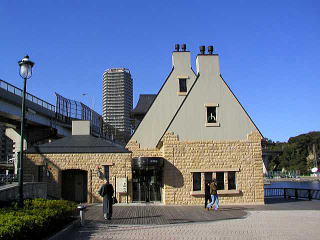 ヴェルニー記念館▲・JR横須賀駅そばのヴェルニー公園西端・入館無料 建物はフランス・ブルターニュ地方の農家を模したデザイン |
When the construction of the Yokosuka Ironworks began in 1865, six Dutch-made
steam hammers were installed as basic machines to support Japan's industrial
revolution. Currently, two of these hammers, one of 3 tons and the other
of 0.5 tons, are on display at the Verney Commemorative Museum in front
of JR Yokosuka Station. Verney Commemorative Museum Location: West end of Verney Park near JR Yokosuka Station Admission: Free The building was designed to resemble a farmhouse in Brittany, France. |
| 3トンハンマー 1865年英国グレン&ロス社製(オランダ・ロッテルダム製は誤りだった…小栗上野介顕彰会機関誌『たつなみ』49号参照)) ヴェルニー記念館はこのハンマーを据えるために作られた。 |
Three-ton hammer Made in Rotterdam, the Netherlands in 1865 The Verny Commemorative Museum was built to house this hammer. |
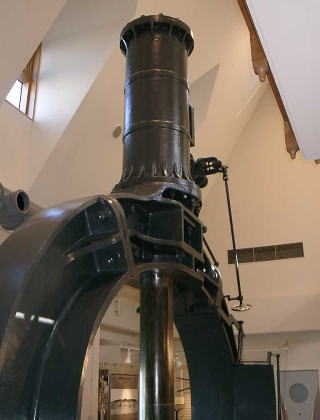 ▲上部 ▼下部 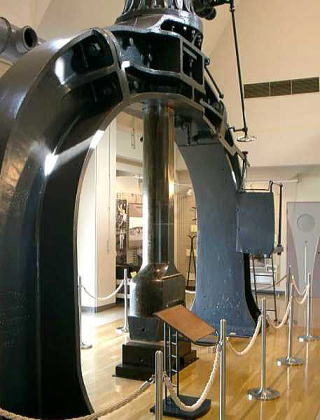 |
▲Top of the machine ▼Bottom of the machine |
| ▲このハンマーも蒸気機関が原動力:蒸気機関の使用が産業革命の基本 This hammer was also powered by the steam engine and the use of the steam engine was fundamental to the Industrial Revolution. |
|
| |
|